#voyeuristic cinematography
Text
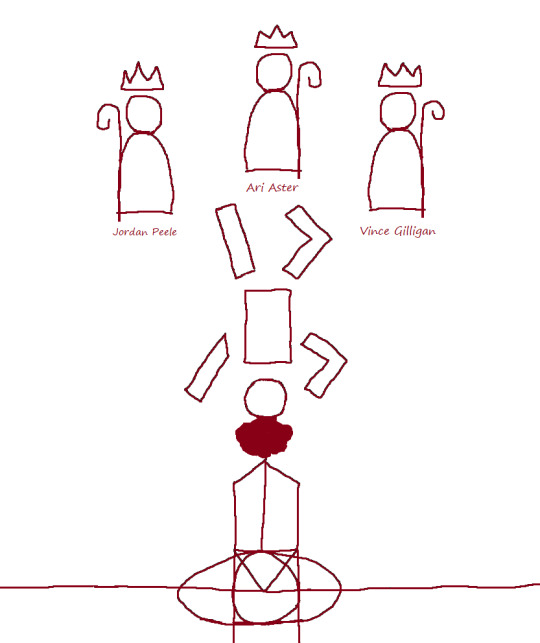
Some art I made before I joined this site.
#vince gilligan#ari aster#jordan peele#modern horror#voyeuristic cinematography#sorry howie#hail paimon
0 notes
Text
I think everyone responsible for producing shows and films about serials killers, especially those who cast actors that are known for having thirsty audiences, should kill themselves
#Jordan Peele was right it’s all about the spectacle#majority of people watching that shit are just being voyeuristic that’s it they don’t really care for the story or cinematography etc#it’s just a voyeurism thing#imagine you’re killed by someone and years later you appear as a fictionalized character on a show where the audience thirsts over the man#killed you#insane#what the fuck are those stories contributing to the artistic world besides satisfying the audiences need for voyeurism#it’s just so sinister to me that people are sitting down after work with their take out and wine and cuddling up watching someone’s true#story of being killed#as a fun evening activity
3 notes
·
View notes
Text
Perhaps it was seeing it on a premium large format screen, perhaps it was my mood that day, or perhaps it is because I'm always drawn to the stories of people trapped inside of their contradictions — but I was impressed with "The Ballad of Songbirds and Snakes" last year, especially with its cinematography and editing. I thought bits of the film, particularly the climax, had shots/rhythm evocative of the great Terrence Malick only to find the film's editor Mark Yoshikawa is a frequent collaborator of Malick.
Now I could talk at length about those comparisons, or the sense of gaze of the film (Tom Blyth's eyes are fascinating to track when he's in close-up/medium shot), or the relationship the wider series has with the medium of television. But I'd rather talk about the beginning of one scene near the beginning of the third-act as an example of effective pacing building dramatic tension and establishing character.

Start on this wide shot at a low-angle. "The Ballad of Songbirds and Snakes" uses low-angle shots frequently, which makes sense in a story about insecurity about power/class gaps. Low or high angles means we see something at an unnatural eye-line — which creates a visual power imbalance.
In the background we have a man just barely peaking over the horizon. This is Coriolanus Snow, our boy from the Capitol who comes from a noble family that lost everything in the war. In the first chunks of the film, we learn that Snow wants to restore his family's former glory. He wants to get that power back. The power gap that we see.
But this isn't the Capitol. This is District 12. This is place he was sent because of his failure. He cheated at the titular Hunger Games to win them for his tribute. So what could he be looking for out here to help him with his desire?

POV shot now. Cutting from that low-angle wide to seeing through Snow's eyes. While it isn't the subject of this post, the POV shot is the most direct expression of gaze. Think about cinema's greatest voyeurist Alfred Hitchcock and all his iconic POV shots ("Vertigo"). Nothing gets inside of a character's head like literally showing what they see.
Snow moves toward something — a something we now know was the (relative) perspective of the first shot.
Or, rather, not a something. But a someone:
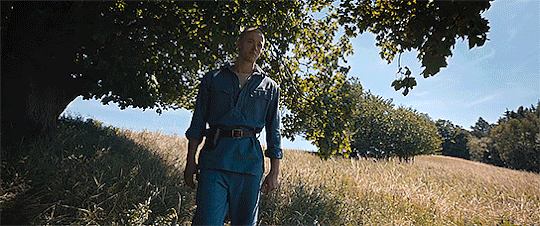
Now back on Snow. Only this time he isn't obscured in the background but near the center of the frame. The camera pushing in before to emulate his movement seen now in his movement. Going toward the someone seen in the previous shot. Someone we couldn't really see before — but now are getting closer to finding.

Close enough to see her guitar.
Of course, if we were listening we would already know that this is Lucy Gray Baird. For her voice echoes through the forest and calls to Snow. But we're sticking to the visual — where we see him pushing toward someone. Pushing toward her.
Baird was his tribute in the Hunger Games. Living (but not hailing from) District 12, she had the lowest odds to win the Games. But through her own determination and a little bit of a push from Snow, she succeeded in winning the Games.
More importantly — she succeeded in winning his heart, as he did to her.
Go back to earlier: the beginning of "The Ballad of Songbirds and Snakes" establishes Snow's desire as reclaiming his family's lost power. Story is conflict, conflict is character, and character is desire. Think mathematically for a moment: Character is action that is a function of desire. But desire cannot remain static. Pull any book or movie off of a shelf at a library. What a character wants at a start will not be the same thing/only thing they want at the end.
Snow began wanting to reclaim his family's lost power. But through this desire — him cheating the games and getting exiled to District 12, the lowest and poorest district in all the land, runs contrary to this desire. He cannot get more power being among the powerless. Why would he act in such a contradictory manner?
Because once he laid his eyes on Lucy Gray, young Coryo had a new desire in his heart. He didn't want to just reclaim what belonged to him, but he also wanted to protect her.
Like all functional drama, this creates a problem — he wants two things that are mutually exclusive. To protect her requires working against the Capitol which means pushing his family further down the social ladder. But to work on restoring his family means throwing her to the odds, and he can't stand thinking of her brown eyes dying out there.
Speaking of brown eyes...

Now we're on Lucy Gray's face. Focus on her and her playing (notice her eyes looking down and not hyperaware of her surroundings), but with another element in the background. Snow coming on the horizon.
Adapting a work from one medium to another always creates new restraints, but also new modes of expression. Condensing a 450-page novel into a ~2.5 hour film requires conveying the emotional arguments of the work in different ways. As such, "The Ballad of Songbirds and Snakes" focuses more on Snow's desires/contradictions than Baird's (even more than the novel) but we still have to some sense of her internal desire to create a compelling character that isn't just an object for Snow's character journey.
Of course, there is the real basic desire of surviving the Games, but that is lackluster and doesn't create real emotional bite. No, her central desire (at least in the film) comes through that one point mentioned earlier — she lived in District 12, but she did not come from District 12. Baird is a wanderer, or at least before the war was part of a wandering culture. Now she is trapped. Her desire is to get back what she lost; she wants to fly as a bird once again.
Look at the above shot. There is no distress on her face. While Snow got exiled for his actions in the prior chunk of the film, Baird got no punishment. She went back to District 12 and could play her music again. Not free to fly high but freer than she was at the start when she got called to fight in the Games.
This natural landscape Baird and Snow find themselves in during this scene is (metaphorical) paradise. It is the closest place to Baird's desire of freedom. The latter bits of the film's third-act use this idea to great dramatic effect.
Baird and Snow's desires both overlap and conflict. Both want to get something that they lost from the war — Snow his status, and Baird her freedom. But their desires operate in opposite direction. Baird wants to go up (free) while Snow is concerned with what's happening down on the ground among the social community. What Snow wants at the start can only be found in having people beneath him, while Baird's is found in having some space to be in.
But recall — Snow also wants to protect her, and this desire comes through a genuine feeling toward her. At the start it may be boyish attraction to her brown eyes and voice, but what his gaze perceived turned into something more. They both want the same thing of undoing loss.

And it's that sameness that pulls Coryo to Lucy Gray. That sameness that pulls him down the social ladder (he has a famous last name, she has no name) and down the society's hierarchy (he is Capitol, she is District) to risk his future for her. That sameness that pulls him to throw his own life and his chance of getting his past back away. That sameness that keeps him walking.
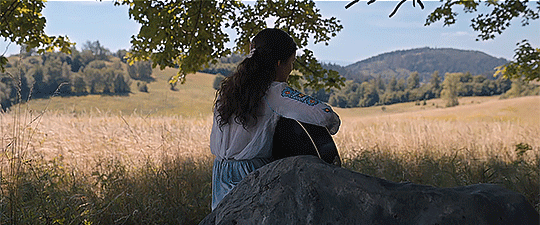
That sameness that makes her bring this strange man into her world. That sameness that makes her trust him with her everything.
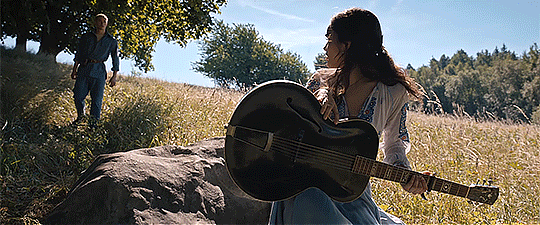
Her personal space out here, far from the suffering in District 12 and the tyrannical bloodshed in the Capitol, now has the presence of that strange man she let inside.
Viewing this natural space as her paradise, she had won this peace but found that her ghost still lingers. A ghost that she doesn't really want to let go of — as evident by her attention going to him, and the unconscious act of her voice calling him here. Remember: nothing in conventional narrative is coincidence or happens spontaneously. Every action a character does is an expression of desire.
Why does she sing? Becuase that's her life. She is a performer. She performed on stage in District 12's bars. She performed when got selected for the Games, which is what first caught Coryo's eyes. She performed for the whole nation to survive in the games. And she performs for Coryo — because she wants to perform for him.
And through this her desire reveals its contradiction. She wants to be free and untethered; to fly like a bird. But she has the same feeling for him that he has for her, and this feeling creates an attachment — a tether. The wanderer found a home.

She could tell him to go away. She could tell him to leave. She could tell him to do whatever. Her words don't matter.
Film is a language of image. Sound (music and dialogue) matter, but ultimately is it a moving picture. A film establishes a character through visual actions. Lucy Gray identifies Coryo, and she stops playing so she can talk to him. So she can go to him. He is pulled into her world — but she is pulled toward him.
Think about the sequence of shots, specifically the POV shots. It is basic movement: start far from the object, and move toward the object. As the character whose POV the camera emulates gets closer to the object, the film cuts back to the opposite side to establish the geography of the scene. But it also creates a little bit of tension — these two forces are coming together and one of them doesn't know it, so what will be the reaction when they come together?
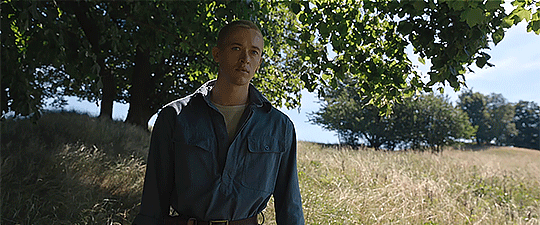
A few frames of static. Coryo stands in anticipation. Waiting to see what she will do.
Go back through these ten shots. Notice they all are of the same vantage point. We see Snow approaching from the horizon, and we see Baird playing her guitar on a rock with Snow coming behind her. While the scene progresses by composing more of the frame around the subject as they get closer together, the core angle remains the same: one shot from him walking and one shot of her point in space. We don't change this basic idea.

Until the scene begins with them coming together to have their first conversation since the Games — which also ends the scene as it shows the distance that remains between them.
They are pulled together, except Coryo stands above her. They both want to be together but they both occupy different places in the social hierarchy that they can never escape. The contradictions of their desires expressed in the blocking of one shot.
#the ballad of songbirds and snakes#snowbaird#tbosas#coriolanus snow#lucy gray baird#film theory#character theory#film analysis#tom blyth#rachel zegler#gifs#didn't revise this at all so i bet there are typos a plenty#it is late#too late
129 notes
·
View notes
Text
"All the Colors of the Dark" (Italian: "Tutti i colori del buio") is an Italian giallo film directed by Martino (1972).
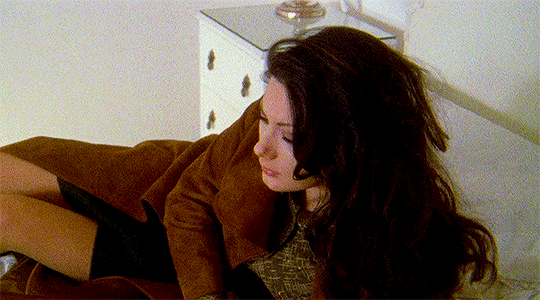
You will love this or hate it. But if you’re a friend of so called “giallo” films, this is a must see❣️

Jane Harrison (Edwige Fenech) is traumatized, she has lost a baby and is seeing nightmares - interestingly “incubi” in Italian language - and is anxious. She seeks help for a sexual dysfunction and nightmares from a psychoanalyst but ends up choosing help from a black mass, on the recommendation of her neighbor.

Needless to say how this results. The plot itself is silly, but film is quite mesmerizing.
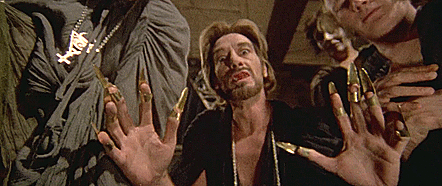
Like usually in giallo, this one is a combination violence, eroticism, and psychological terror. Giallo films are known for their distinctive visual style, which includes vibrant cinematography, stylized lighting, and creative camera work.

Witchcraft in the film has a satan worshipping -nature and it in many places resembles the Polanski’s Rosemary's Baby (perhaps even more the Repulsion). On the other hand it is like Buñuel‘s Belle de Jour.
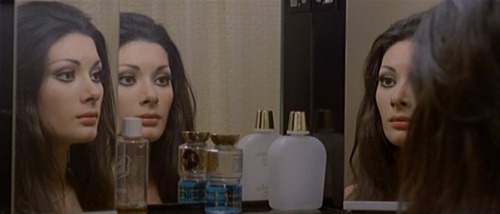
Very voyeuristic film in a Russ Meyer manner, but I wouldn’t say that there is purely “male gaze” setting, because this isn’t a Hollywood flick and there is a hint of feminism involved.

The film tackles themes of paranoia, trauma, and the blurred lines between reality and illusion.
⭐️⭐️⭐️⭐️⭐️
🎼🎼🎼🎼🎼
🎥🎥🎥🎥🎥
🧹🧹
youtube
#witchcraft#witch#witches#movies#giallo#allcolorsofthedark#tutti i colori del buio#film#horror film#cinema#italian horror#edwige fenech#horror#psychology#great britain#Youtube
12 notes
·
View notes
Text
OK Horror Fans
I've recently seen two new-to-me horror movies (one of them almost a month ago) and I wanted to share some thoughts.
The first one is Skinamarink.

I went into this one not really knowing what to expect...I wasn't even sure I was going to like it, as ratings/reviews are pretty split.
But I gotta tell you, this is one of the more uncomfortable movies I've seen in a long time. It is probably the closest a movie has ever come to capturing what it feels like to be trapped in a nightmare.
Told from the point of view of two small children, who wake up one night to find their father gone. Not only that, but the doors and windows to the home have vanished, and the phones do not work...leaving them trapped inside this house, alone...or so they think.
This feels very much like an experimental film...there is barely any dialogue, and we never see the faces of the children...nearly everything is shot from their point of view; and when the camera does pull back, it feels so voyeuristic and uncomfortable. The shots are long and static, often looking towards a dark hallway or corner...and you just have to sit there, waiting for something to jump out at you...and then it doesn't.
While this movie will not be for everyone, I would definitely suggest it if anything I said has piqued your interest. It is a very slow film, that maybe could have been 10-15 minutes shorter (this movie has more endings than The Return of the King). But the discomfort I felt was palatable, and there was at least one shot that absolutely freaked me the fuck out that I had to look away.
Also, the sound design is insanely good. There is no soundtrack, so all we have are the ambient sounds in that house and it really gets to you after a while.

And the other night I watched The First Omen.

Damn, this was a good movie.
The First Omen is a prequel to the 1976 film: The Omen, starring Gregory Peck and Lee Remick. And as with most horror prequels and sequels, I was not expecting this to be very good, but I was pleasantly surprised!
The film follows a young, American novice named Maggie (played by the fantastic Nell Tiger Free) who has come to Rome to complete her novitiate before taking her final vows to become a nun. But strange things begin to happen, and she discovers that not everything is as it seems, and there is something nefarious going on behind closed doors within the church.
First of all, this movie looks incredible. This is director Arkasha Stevenson's first feature film, and I cannot wait to see what she does next. Because the cinematography, the lighting, the angles and editing...everything about the way this movie looks is terrific. And the set and costume design (as well as the practical effects) really brought the feeling of the early 1970's...it didn't feel like a 2024 take on the 1971.
And there is so much tension in this movie! The build-up is so well done, with maybe one or two small scares at the beginning, but then this feeling of dread and discomfort starts to build that doesn't really let go until the end. Really well done, and I hope we're going back to this kind of horror for the future, because I really love movies that do this.
Honestly, my only real gripe with the film is the fact that they changed one thing that effects the original film. I can't really say much because of spoilers...if you've seen the trailer, you may be able to guess what it is...but with the change, it makes a plot point in the original into a plot hole. I'm kind of ok with it, since The Omen was never a big favorite of mine...and if they hadn't made this change, then we wouldn't have this movie...at least as a prequel to The Omen. Though if they had taken out the few references to the original (and yes, you do get to hear a bit of Jerry Goldsmith's incredible score), it could have worked as its own standalone movie.
Despite this one change, I would absolutely recommend this movie to horror fans!

4 notes
·
View notes
Text
Recently Viewed: Door
[The following review contains SPOILERS; YOU HAVE BEEN WARNED!]
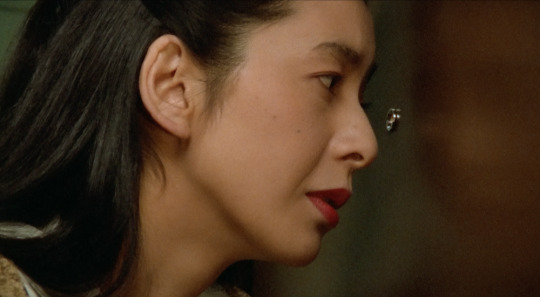
When I first discovered the existence of Banmei Takahashi’s Door earlier this year (via various clips shared by fan accounts on Twitter), it was love at first sight. Luckily, while the movie currently lacks official distribution in the United States, I didn’t need to wait very long at all to see it (compared to Angel’s Egg, A Page of Madness, and Samurai Wolf, anyway) thanks to the Brooklyn Horror Film Festival, which screened it just before midnight on Friday, October 13th—basically the ideal context in which to experience its unique brand of madness.
The premise is as brilliant as it is straightforward: an ordinary housewife—already fed up with cold callers and their seemingly unlimited access to her family’s personal information—aggressively turns away an especially persistent salesman, slamming the door on his fingers after he ignores her repeated protests and attempts to force his way into her apartment. Unfortunately, this moment of instinctive panic has severe repercussions, resulting in an excruciatingly tense game of cat-and-mouse as the slighted pamphlet pusher’s vengeful wrath gradually evolves into perverse sexual obsession.

It’s a captivatingly mundane flavor of terror, twisting a familiar, relatable scenario into an inescapable nightmare. There’s nothing particularly memorable or remarkable about the central villain. He has no elaborate costume or mask, no supernatural abilities or distinguishing features; unlike Jason Voorhees, Michael Myers, and Leatherface, he doesn’t even wield a signature weapon (though he is quite handy with the absurdly convenient electric chainsaw that he scavenges from the protagonist’s collection of otherwise run-of-the-mill home appliances). This anonymity is absolutely chilling; he effortlessly blends in with the crowd—average, unassuming, invisible. Indeed, his façade of superficial “normalcy” is far more insidious than any explicit display of insanity; he taunts his prey with idle banter, seamlessly transitioning between casual flirtation and thinly veiled threats.
The director’s visual style perfectly complements the suspenseful tone of the narrative. Early scenes almost resemble a slice-of-life domestic drama, characterized by flat compositions and lighting. As the conflict escalates, however, the warm, inviting interiors slowly warp and distort, becoming cramped, claustrophobic, hostile. Foreground elements (potted plants, sculptures, windows, doorways) isolate our heroine within the frame, emphasizing her vulnerability. Voyeuristic point-of-view shots serve a similar purpose, subliminally insinuating that true “safety” is an illusion: the sinister stalker could be lurking around any shadowy corner. The increasingly maximalist cinematography culminates in the film’s most iconic sequence: a prolonged overhead angle that follows the now totally unhinged maniac as he relentlessly pursues his quarry from room to room, utterly demolishing every obstacle in his path—splintering wood, shattering glass, and reducing drywall to dust.
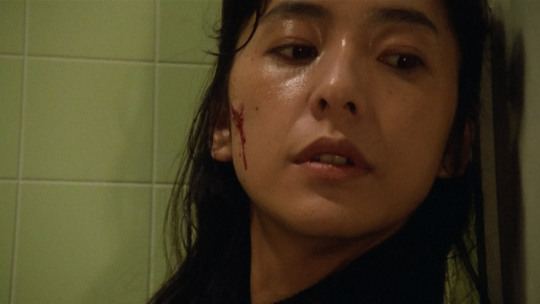
Yet some of the movie’s most haunting images are significantly less spectacular than this climactic set piece. Takahashi understands the inherent value of patience, frequently locking down the camera and lingering on long, uninterrupted closeups of his lead actress simply reacting to suspicious offscreen noises—the echo of footsteps in the corridor, for example, or the telltale rattle of the deadbolt being tested. Keiko Takahashi’s face is breathtakingly expressive; her turbulent emotions are palpable, a violent maelstrom of anxiety, desperation, and paralyzing fear clearly evident in every twitch of her eye, every crease in her brow, every tear staining her cheek.
How thematically appropriate that Door—a story that explores such everyday horrors as rampant commercialism, predatory marketing, and the erosion of privacy—should be at its scariest when it embraces naturalism, minimalism, and subtlety.
#Door#Banmei Takahashi#Keiko Takahashi#Japanese film#Japanese cinema#Japanese horror#J horror#Brooklyn Horror Film Festival#Arrow Video#Nitehawk Cinema#horror#Halloween 2023#film#writing#movie review
7 notes
·
View notes
Text
When you talk about a show being palatable to a larger audience, Goblin Slayer falls pretty much at the opposite end of that ideal.
It goes out of its way to inflict trauma on the audience; to display horrible things and linger on them; to draw out uglier emotions from the viewer.
This is interesting to me because it means there are many potential viewers who simply wouldn't be able to stomach this show. At the same time, it's one of the better-written high-fantasy (that is, "Tolkien-inspired") anime I've seen in a while. It also reminds me of Record of Lodoss War for all the times it cleaves to old ttrpg tropes.
I wonder what inspired the decision to make the cinematography of this anime as mean-spirited as it is. Do they feel as if the story of vengeance can't be told without the audience feeling the trauma of the vengeance-seeker? Is it a rite of passage or a kind of gatekeeping - a kind of "You must be this thick-skinned to enter" thing? Or is the author just a pretty decent writer who also happens to be a pervert and he decided to include sexual assault in his story because he could?
Also I kind of dig the harem setup in this one? Because it's tragic? Because every one of these young women interested in Goblin Slayer recognizes that there's a high chance this broken man won't ever understand their feelings toward him, let alone reciprocate.
At the same time it's a pretty blatant case of shoving the audience into a voyeuristic role without having that say anything in the story, which makes some of the cinematography borderline pornographic. Like, even the tired old 80s films with the peeping tom trope had the purpose of expressing the stupid and breathless excitement of a young boy transgressing as part of his sexual awakening. Didn't always say something wise, but it said something. A lot of the titillation in Goblin Slayer is there for its own sake and happens when we the audience are the only ones there to appreciate the weird camera angles.
The first episode is the worst one, in my opinion. If you're interested in the series maybe try starting at episode 2.
12 notes
·
View notes
Text
The Fantabulous Comeback of Harley Quinn
“Behind every great man is a badass broad!”
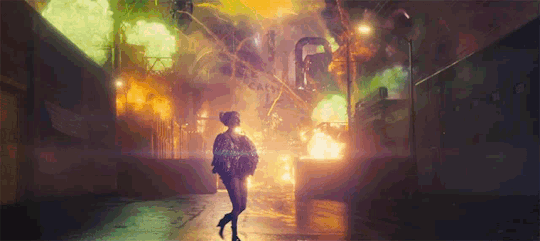
Birds of Prey: And the Fantabulous Emancipation of One Harley Quinn follows the iconic antiheroine: Harley Quinn, as she navigates life after finally leaving her abusive and dependent ex, Joker. Unlike her previous fetishized depiction in Suicide Squad, Harley is no longer hyper-sexualized through the male gaze. Instead, the sequel consists of a female-fronted team, of all ages, races, and sexual orientations. Thus, the film is shown through both a female and queer gaze. It intentionally and unapologetically subverts the male gaze, but in an authentic way by focusing on the relationship between the five female characters. From cinematography to characterization, Birds of Prey quite literally said “fuck you” to Suicide Squad and completely reconstructed the gaze, surpassing its predecessor in every way possible.
Perhaps the most circulated image of Harley Quinn, is Margot Robbie stripping her clothes in Suicide Squad in an overtly sexual manner, shamelessly catering to the male gaze. It is interesting to note how only Harley had an undressing scene as her male counterparts stared in desire. Her body is constantly objectified by the camera through closeups of her bare body, almost never focusing on the face.

In Birds of Prey, a similar scene of undressing occurs, except this time, the cinematography does not objectify the female victim. The villain of the film, Black Mask, forces a man to undress a woman in public, with spectators all over. Instead of the camera closing in and panning on the undressed body, the cinematography focuses on the horrified face of the woman, and those around her. It reveals the villain’s nature without the expense of sexualizing the female victim. It doesn’t glorify rape culture like most, if not all, scenes of assaults on women do. Instead, the film accentuates the sheer pain and horror women feel when being sexually harassed or assaulted. And with that, a message to all male directors: it’s really not that difficult to show violence against women without sexualizing them.
In Suicide Squad, Harley was only seen through the views of others, but in Birds of Prey, she narrates her own story, displaying her independence and fun personality without being sexualized, or de-sexualized. The spectrum of women in superhero films is often either innocent and cute or overly sexualized and mischievous. Character development is non-existent. God forbid women are allowed to be complex and flawed. Relentlessly, Birds of Prey addresses this and seeks to set a new spectrum for women to exist outside of male desires. This is also seen in the characterization of men. The men, including the villains, are not all displayed in a “macho” or “manly” style. Instead of the sexualization of their ab muscles, we see their reserved personalities. Men actually show emotions (one even cries) in this film! They don’t have to be unemotional or bold, they can be calculating and resourceful – something apparently only women can be.

Moving on to the most obvious difference – Harley Quinn’s fantabulous ‘I-need-no-man’ makeover. Previously, Harley’s appearance in Suicide Squad is truly voyeuristic-scopophilia come to life, fetishized beyond belief. Thankfully she now sports colorful, and playful, outfits that put comfort above all. Yes, it is still revealing but it is evidently a creative choice made by Harley herself, reflecting her explosive personality. Instead of wearing lingerie to sexily fight (sorry boys), she can now comfortably kill in t-shirts and pants.
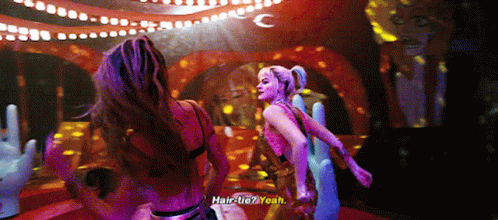
Finally, slipping in my favorite scene when Harley offers a hair tie to Black Canary mid-fight, I thought to myself: “this is it... this is what it is to be a woman.” As a woman, this is the ultimate form of solidarity. A small but powerful act that I’m sure all women have experienced. Truly, this is a film made by women, about women, for women.
Birds of Prey flips the switch from Suicide Squad, and introduces a new Harley Quinn: no longer Joker’s property, she becomes fiery, vibrant, and most importantly, an individual woman. Yes, she still has faults, and sure, she has brutally tortured and killed many, but it is precisely this freedom of flaws that breaks stereotypes and solidifies Birds of Prey as a superior woman’s film.

#harley quinn#birds of prey#film review#birds of prey and the fantabulous emancipation of one harley quinn
22 notes
·
View notes
Note
Do you think Sonic 3 can be dark without Being PG-13 and still be PG
Well, yeah, have you seen what PG movies are capable of these days? Puss in Boots had a character bleed on-screen. Mutant Mayhem had characters say "damn". Not to mention, Sonic Adventure 2 has an E10 rating, it is a game for kids.
The only reason I can think for it being PG-13 is the scene with GUN gunning down Maria, which could easily be solved by cinematography. You don't see Maria get shot, you see a close-up of Shadow's horrified face as the bullet goes off. Ngl, having the scene be graphically violent feels kinda voyeuristic. If we know Shadow was traumatized by having his sister shot in front of him, that's enough for it to carry it's weight effectively.
8 notes
·
View notes
Text
a taxi driver (2017) has a dual purpose: the first to establish the importance of reporting and historical narrative, and the second to report and provide historical narrative of the actual events it reports, the gwangju uprising of 1980. most films about a mercenary reporter obsessed with recording the highly poignant events around him choose one of two routes: either villainize the voyeuristic act of filming and have the reporter jettison his camera in order to become involved in events, or lionize the noble act of filming and frame the recording and communication of events as an intrinsic and indeed one of the highest parts of involvement with the events. this film decidedly takes the second route. not only does this film’s secondary protagonist, a german reporter sneaking through the military blockade of gwangju, receive support and sacrifice from virtually all the other characters to further his task of recording and sharing the truth of the uprising—and, significantly, it is through aiding him that the protagonist finds redemption—but the film itself furthers his project by showing at length the things he is filming. this is the second clear purpose of the film, to educate the audience and especially the foreign audience about the gwangju uprising. the film carefully introduces the audience to the context and cultural milieu, guiding us in through the eyes of a character who, like us, does not know much about these events and, like us, does not have much reason to care. the tension and stakes ramp up bit by bit for both audience and protagonist, until at last we and he are fully enmeshed in the spirit and mission of the uprising. i did feel that the extreme emotionality of the filmmaking—the particularly intense score, the particularly dramatic cinematography—draw on a bit too long and end up drawing attention to themselves, but until and even past that point these devices are still very effective. by unifying the goals of the central character and the film itself, a taxi driver (2017) does a highly focused and highly effective job of depicting the events and weight of the gwangju uprising, and emphasizing the value of the act of depiction
#it felt a little rough at the end tbh#but there was still some Damn good acting#and yeah. i cried. what of it.#ryddles
14 notes
·
View notes
Note
One of the things succession is good at its presenting shame and humiliation in such a real way. It makes you feel like a voyeur like you are intruding on a private moment, you want to look away but you can’t. You can feel it in your teeth,in your hands. You feel like you are in the room where it’s happening you get a full body reaction and your legs are itching to stand up and leave the room. This isn’t just Kendall (tho Jeremy Strong does an incredible job) but every character even Logan.
I think that’s really brilliant also It really helps that the actors are not afraid of looking ugly when expressing strong emotions.
interesting, in general i feel like the effect of the cinematography for me is less voyeuristic and more immersive. like i definitely notice shots that are more voyeuristic (ken and shiv on tv, the beginning of roman and mencken in the bathroom, etc) because it breaks from the way the camera normally feels like it's just a silent member of the roy family in the room.
i agree though that the acting is great across the board, and especially there are some really fantastic moments with all of the kids being humiliated by / in front of logan
7 notes
·
View notes
Text
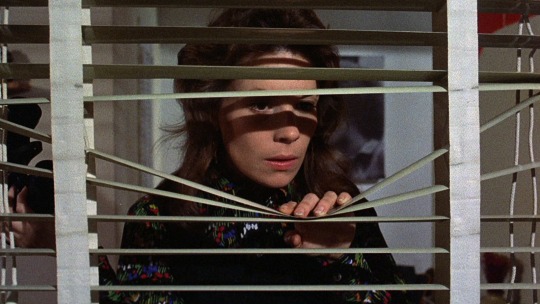
Jennifer Salt in Sisters (Brian De Palma, 1973)
Cast: Margot Kidder, Jennifer Salt, Charles Durning, William Finley, Lisle Wilson, Barnard Hughes, Mary Davenport, Dolph Sweet. Screenplay: Brian De Palma, Louisa Rose. Cinematography: Gregory Sandor. Production design: Gary Weist. Film editing: Paul Hirsch. Music: Bernard Herrmann.
You can get caught up playing Spot the Steal while watching Brian De Palma's Sisters as he steals from Alfred Hitchcock's Rear Window (1954), borrows from Psycho (1960), or pays homage to Rope (1948), as many critics have noted. He also called out of retirement the composer most associated with Hitchcock, Bernard Herrmann, to compose the score. But the central borrowing is of Hitchcock's most prevalent theme: voyeurism. In the opening scene, Danielle (Margot Kidder) and Phillip (Lisle Wilson) appear on a parody of a reality game show that has a voyeuristic premise: He's a man changing in a locker room when she enters on the other side of a partition that has some missing panels. When he realizes that she's blind and she starts to change clothes, what should he do? The contestants on the show have to predict his action: Will he watch? Will he tell her he can see her? Will he turn away? After the show, Phillip learns that Danielle is not really blind, and they go out to dinner and then back to her apartment where he spends the night with her. But he encounters some complications: He learns that she has a jealous ex-husband (William Finley) and that she has a twin sister named Dominique who is staying overnight in her bedroom because it's the twins' birthday. What happens next is partly witnessed by another voyeur: Grace (Jennifer Salt), a journalist (she writes a column for a Staten Island newspaper but dreams of better things) who witnesses some of what happens in Danielle's apartment from her own across a courtyard. But when she calls the police to tell them what she saw, at first they don't believe her (she has written articles criticizing the cops), and then when they go to Danielle's apartment there's no evidence that what she saw has happened there. We know the truth, so the suspense in the rest of the film comes from Grace's attempt, with the help of a private detective (Charles Durning), to uncover both the crime and the cleanup. It's a nicely plotted variation on the Hitchcockian theme. The film suffers because Grace is written and overplayed as a nervous wreck, plagued by an interfering mother (Mary Davenport), another Hitchcockian trope. And the revelation that Danielle and Dominique were conjoined twins who were separated introduces some not too convincing psychology. But the suspense and the ironic ending are nicely handled. Watch for Olympia Dukakis in a bit part as a woman behind the counter of a bakery.
2 notes
·
View notes
Text
Finally got around to the first episode of The Curse today, really interesting show. It spent a lot more time talking about Nathan Fielder's dick than I expected, but I really liked it, I think. Definitely does a good job at making you feel uncomfortable.
It reminded me a lot of Perfect Blue, funnily enough. It does the same thing where it's a show about people making a TV show, with an emphasis on how shady and exploitive the process is. Even the cinematography has a similar focus on capturing characters in reflections, or from far away, in kind of weird framings. Very voyeuristic. It's all pretty impressive, especially for live action.
And Nathan Fielder's performance. Oh my god. Like I don't even know what to say. There's this one scene in the first episode - iykyk - that just blew me away. So much tension and weird energy packed into a character, masterful acting. I've been following him since Nathan For You, and I think I can definitively say he's one of the most talented people working in Hollywood right now.
1 note
·
View note
Text
Nobody Has Seen My Favourite Film
So my favourite film ever is called Frank.
No, not Frank (2014), Frank (2012). No one has heard of it. Well, next to no one, anyway. But I love it with my entire body and soul. So much so, that if you go to Letterboxd or Vimeo you will immediately be able to identify my accounts for both websites.
It has a completely insane mesh of genres, was clearly made by people who cared about what they were making and (best of all) was made in the North East (of England) so holds a particular pull for me.

Frank isn't niche because it's not good, obviously I think it's great, but actually it is objectively well made. Its problem is that it is a microbudget film. That means exactly what you think it does, and it's not hard to guess why films with unbelievebly tiny budgets will often have unbelievebly tiny audiences.
What I think, though, is that Frank does have an audience out there.
The synopsis of the film is this:
Caught up in a world he doesn’t fit into, FRANK tells the unique story of an lonely outsider who manages to find friends in the strangest of places.
Now don't get me wrong, that is sort of what the film is, but Frank is infinitely more weird and infinitely less heartwarming than the synopsis implies.
Letterboxd counts it as a drama, which also isn't quite right.
Horror is definitely wrong, but but would prepare you for some of the gorier bits.
Thriller? Nope, don't think so. The film does have a certain tension to it, but it's not the core of the film.
Maybe I'm just being precious over a film I love, there are loads of films that don't fit firmly into one genre.
I'd maybe put it in that strange space where films like Gummo, Tideland and The Wolf House belong. The sort of film that takes a naive child's view of something terrible and makes it into something...... meaningful?
Look, I don't know how to describe this film better than anyone else, but I'm trying to sell it here. So here are some points that might get you (my Tumblr based audience) to pay attention:
Con O'Neill is in it, and plays an absolute blinder
The cinematography is (in large parts) the sort of stuff people like to put on their pretty aesthetic blogs
The main character has learning difficulties and OCD. It's actually a really interesting portrayal of someone who is struggling with mental health issues and manages to be compassionate without feeling voyeuristic
Despite the budget for this film being about £2.35 it actually sounds great, and the editing is pretty tight. If you're into films I'd say it's worth a watch just to see the sort of things people can do on a shoestring
Once again, you can watch it FOR FREE
Con O'Neill is in it
If you hate it you have permission to argue with me. You are wrong, but I will humour you
It's funny and heartbreaking and bizzare and if you want to be pulled into a story where you can feel a million things at once this is exactly that. The script is so strong that you forget the budget and all you have is the story in front of you
Good enough?
"I'm not going to waste too many more words, and I won't try to explain this film to you - I really believe it's best to go into it blind, because some of what stuck in my mind for so long was the not quite ever knowing what to expect next.
If you get a chance, please watch it. You might think I'm insane for liking it, but if I even let one single person adore this film like I do, that would be plenty. I promise that it deserves the love."
#letterboxd#movies#film#film recommendations#please watch this film it is my baby and i want it to go out into the world and flourish#my essays
4 notes
·
View notes
Text
Film Rec: High Life (2018) dir. Claire Denis

Medium: Film
Genre: Fuckbox in Space (but make it Art)
Tags/Content Warnings: major character death (in spades), graphic depictions of rape, graphic depiction of sexual assault, murder, nonconsensual drugging, nonconsensual somnophilia, abuse of incarcerated people, forced pregnancy, medical abuse, medical experimentation, racism between characters, anti-Blackness (between characters), infant death, animal death, death of a pet, death of dogs, brief somewhat mild gore, voyeurism, the cutest damn baby you’ve ever seen
tl;dr: I would not recommend this movie if you are uncomfortable with depictions of rape or violence.
Are you ever in the mood to watch something that will fuck you up for a week or more? High Life (2018) will deliver. Featuring mumblecore Robert Pattinson (before The Batman made it cool), a superlatively terrifying and electric performance from Juliette Binoche (mark me down as scared and horny), and a very literal fuck machine in space, High Life is one you won’t soon forget.
The film follows death row inmates who have agreed to an experimental suicide mission to space under the guise of advancing science, namely to record data on the galaxy’s nearest black hole. The film follows Monte (Pattinson) as he raises his infant and then teenage daughter Willow (Jessie Ross, Scarlett Lindsey) alone in deep space cut off from human civilization, slowly revealing what transpired with the mission, the ship crew and leader (Binoche), and Willow’s mother (Mia Goth). The relationship between a father and a daughter who has known nothing but the derelict ship and her silent yet devoted guardian is the terse, prickly vehicle.
Denis is an unorthodox and immensely visionary director, crafting a narrative that layers unflinching horrors with unsentimental moments of unexpected tenderness. High Life reveals the worst of humanity in a way that is more matter-of-fact than didactic. Denis’ conceit is daring and demanding, and the script, performances, and cinematography rise to the challenge. Churning with conflict, exploding into violence, revelling in quiet beauty and brutalities alike, the camera lingers in a voyeuristic fashion over it all, never bogged down in a single moment or allowing the viewer more than a moment’s respite.
Denis is uncompromising in her pursuit of her vision, responding to a question during the film’s screening about why she does not portray more strong female characters with a succinct (and very French) response: “I’m not a social worker.” High Life marks her English language debut and is distributed in the US by A24.
High Life is available to stream on Netflix (US, Canada, possibly others) or uh, wherever you get movies.
Recommender: Hannah P. | Managing Editor
2 notes
·
View notes
Text
peaky blinders rubs me the wrong way because it had such a talented cast and decent budget and nice cinematography and occasionally really interesting ideas, it could have been good! and instead it's more of this absurd "the world is so bad, evil always wins one way or another, nothing is more interesting than violence and cruelty" nonsense that I despise.
I don't believe that that is true, I don't believe that that's a useful or even a neutral message, and I certainly don't believe it makes a story better in any way. they could have had almost all the same beats with just slightly less cruelty. and you can't even really argue that they're making a point about the pointlessness of violence when it's almost always filmed in this voyeuristic way and it makes up 90% of the series.
#I'm being made to rewatch it against my will and it's just... so much#no character can ever be a decent person for more than half a scene and HOW is that more realistic or interesting#it's so bad that you then get billions of videos and posts about 'sigma male' tommy shelby#when he's both a piece of shit and clearly not well. so sigma of him.#but it's not even an entirely baseless reading of the series because almost everyone in it sucks anyway and he's the mc and also smart#which is the only remotely positive thing that can be said about him or any other character in the series#and that's to say nothing of the constant misogyny but in that regard at least it's hardly different from a lot of other shows#peaky blinders#mine
0 notes